Text



Lovebird Meal Time - April 2023
A simple aviary, occupied by lovebirds. There are several unique lovebird colors in this aviary, there are euwing lovebirds, parblue lovebirds, opaline lovebirds, and others such as creamino and lutino, and there are also albino lovebirds. The colors of this lovebird are also beautiful, green, blue, yellow, turquoise, white, violet, orange, all mixed in pastel colors and also the color patterns on some lovebirds.
This time we fed the lovebirds the usual vegetables, namely purple cabbage, white cabbage, chicory, mustard greens, mung bean sprouts, and sliced carrots and also kangkung leaves. Everything is raw with no need for cooking or boiling. Sometimes we also feed them raw sweet corn and broccoli, that too without needing to cook or boil them.
We also gave them some food seeds, namely canary seeds, millet, mustard seeds, rice seeds, wheat seeds, oat seeds, and others.
youtube
#lovebird sounds#love birds#lovebird singing#lovebirds#lovebird#videokameraku#love bird#lovebird video#pet parrot#parrot video#small parrot#parrots#aviary breeding#lovebirds aviary#lovebird aviary#parrot aviary#Youtube
0 notes
Text




Personata and Fischer's Lovebirds - July 2023
The lovebirds are having lunch. They enjoy kale leaves, Chinese mustard leaves, and lettuce. We also feed them fresh sprouts and also sweet corn. This time we tried to serve additional seeds, they are soybeans and mung bean. The seeds must first be soaked in clean water, about an hour is enough for soybean seeds, and for mung beans it can be around 5 hours, after that the seeds will soften and are ready to be served to these little parrots.
youtube
#lovebird#videokameraku#love birds#lovebirds#love bird#lovebird video#personata lovebird#lovebird personata#agapornis personata#personata#fischeri lovebird#lovebird fischer#lovebird fischeri#agapornis fischeri#lovebird aviary#lovebirds aviary#parrot aviary#small parrot#pet parrot#parrot video#Youtube
0 notes
Text
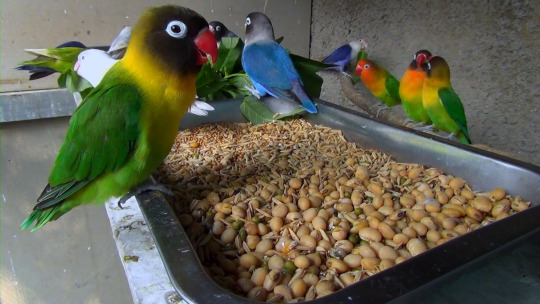
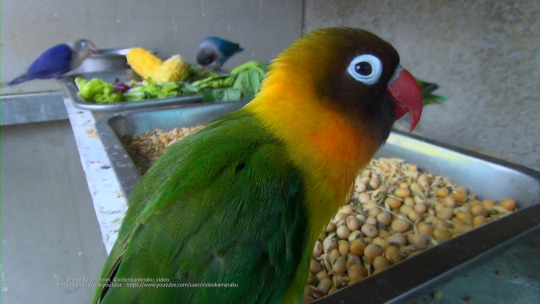
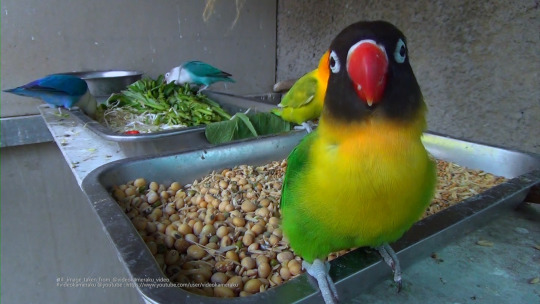
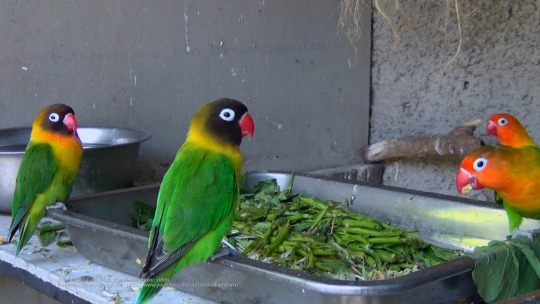
Personata and Fischer's Lovebirds - July 2023
The lovebirds are having lunch. They enjoy kale leaves, Chinese mustard leaves, and lettuce. We also feed them fresh sprouts and also sweet corn. This time we tried to serve additional seeds, they are soybeans and mung bean. The seeds must first be soaked in clean water, about an hour is enough for soybean seeds, and for mung beans it can be around 5 hours, after that the seeds will soften and are ready to be served to these little parrots.
youtube
#lovebird#videokameraku#love birds#lovebirds#love bird#lovebird video#personata lovebird#lovebird personata#personata#agapornis personata#fischeri lovebird#lovebird fischer#lovebird fischeri#agapornis fischeri#lovebirds aviary#lovebird aviary#parrot video#small parrot#pet parrot#parrots#Youtube
0 notes
Text
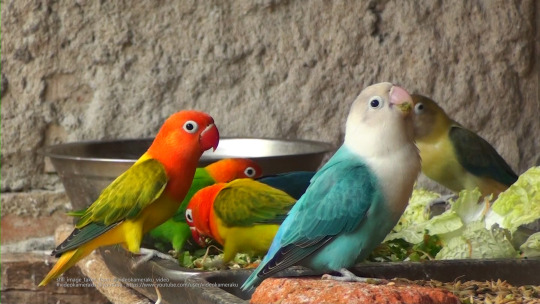
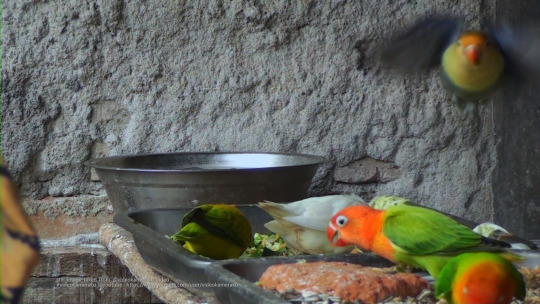
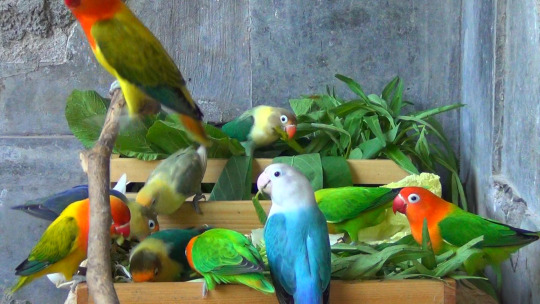
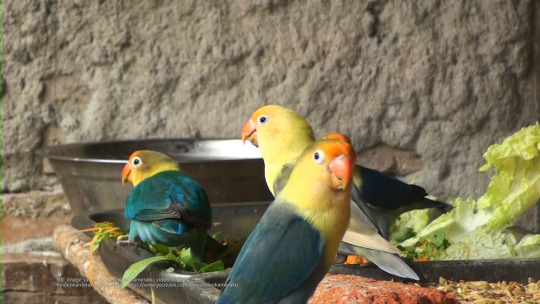
Lovebird Meal Time - April 2023
A simple aviary, occupied by lovebirds. There are several unique lovebird colors in this aviary, there are euwing lovebirds, parblue lovebirds, opaline lovebirds, and others such as creamino and lutino, and there are also albino lovebirds. The colors of this lovebird are also beautiful, green, blue, yellow, turquoise, white, violet, orange, all mixed in pastel colors and also the color patterns on some lovebirds.
This time we fed the lovebirds the usual vegetables, namely purple cabbage, white cabbage, chicory, mustard greens, mung bean sprouts, and sliced carrots and also kangkung leaves. Everything is raw with no need for cooking or boiling. Sometimes we also feed them raw sweet corn and broccoli, that too without needing to cook or boil them.
We also gave them some food seeds, namely canary seeds, millet, mustard seeds, rice seeds, wheat seeds, oat seeds, and others.
youtube
#lovebird sounds#love birds#lovebirds#lovebird#videokameraku#love bird#lovebird video#lovebird euwing green#euwing gold opaline#euwing green opaline#lovebird euwing#aviary breeding#lovebirds aviary#lovebird aviary#parrot aviary#aviary#parrot video#small parrot#Youtube
0 notes
Text


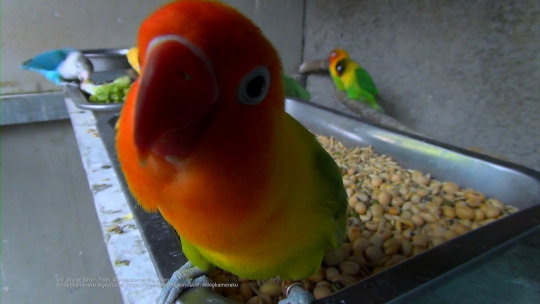
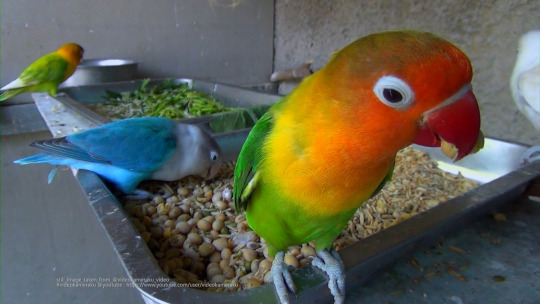
Personata and Fischer's Lovebirds - July 2023
The lovebirds are having lunch. They enjoy kale leaves, Chinese mustard leaves, and lettuce. We also feed them fresh sprouts and also sweet corn. This time we tried to serve additional seeds, they are soybeans and mung bean. The seeds must first be soaked in clean water, about an hour is enough for soybean seeds, and for mung beans it can be around 5 hours, after that the seeds will soften and are ready to be served to these little parrots.
youtube
#lovebirds#lovebird#videokameraku#love birds#love bird#lovebird video#personata lovebird#lovebird personata#personata#agapornis personata#fischeri lovebird#lovebird fischer#agapornis fischeri#lovebirds aviary#lovebird aviary#parrot aviary#parrot video#small parrot#Youtube
0 notes
Text

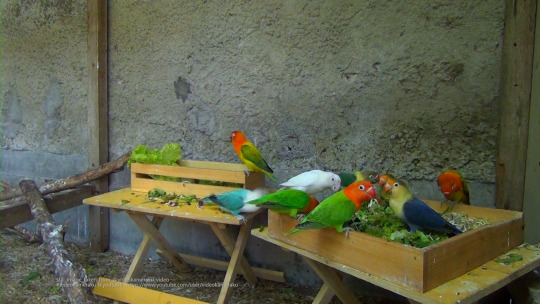
Lovebirds Meal Time June 2023
Video of lovebirds enjoying fresh vegetables and seeds. There are about more than twenty lovebirds in this simple cage aviary, most of them are adults, and there are several young lovebirds that also hatch and grow here. Here there are several types of lovebird colors, these are euwing, opaline, parblue, lutino and albino. Fresh vegetables: Green lettuce, small mung bean sprouts, large mung bean sprouts, kangkung leaves, green mustard leaves, pokcoy mustard leaves, fresh chicory, white cabbage and purple cabbage, there is also water spinach.
Fresh vegetables: Green lettuce, small mung bean sprouts, large mung bean sprouts, kangkung leaves, green mustard leaves, pokcoy mustard leaves, fresh chicory, white cabbage and purple cabbage, there is also water spinach.
youtube
#videokameraku#lovebird#lovebirds#love birds#love bird#lovebird video#lovebird albino#lutino lovebird#lovebird aviary#lovebirds aviary#parrot aviary#aviary breeding#lovebird euwing green#euwing gold opaline#euwing green opaline#lovebird euwing#lovebird green opaline#lovebird opaline#green opaline#Youtube
0 notes
Text

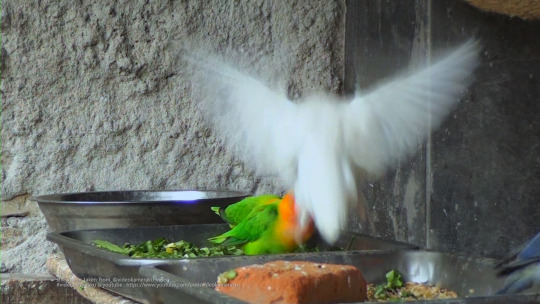



Lovebird Meal Time - April 2023
A simple aviary, occupied by lovebirds. There are several unique lovebird colors in this aviary, there are euwing lovebirds, parblue lovebirds, opaline lovebirds, and others such as creamino and lutino, and there are also albino lovebirds. The colors of this lovebird are also beautiful, green, blue, yellow, turquoise, white, violet, orange, all mixed in pastel colors and also the color patterns on some lovebirds.
This time we fed the lovebirds the usual vegetables, namely purple cabbage, white cabbage, chicory, mustard greens, mung bean sprouts, and sliced carrots and also kangkung leaves. Everything is raw with no need for cooking or boiling. Sometimes we also feed them raw sweet corn and broccoli, that too without needing to cook or boil them.
We also gave them some food seeds, namely canary seeds, millet, mustard seeds, rice seeds, wheat seeds, oat seeds, and others.
youtube
#love birds#lovebird#lovebirds#videokameraku#love bird#lovebird video#euwing green opaline#euwing gold opaline#lovebird euwing green#lovebird euwing#pet parrot#pastel green#parrots#small parrot#lovebirds aviary#aviary breeding#parrot aviary#Youtube
0 notes
Text


Lovebirds Meal Time June 2023
Video of lovebirds enjoying fresh vegetables and seeds. There are about more than twenty lovebirds in this simple cage aviary, most of them are adults, and there are several young lovebirds that also hatch and grow here. Here there are several types of lovebird colors, these are euwing, opaline, parblue, lutino and albino. Fresh vegetables: Green lettuce, small mung bean sprouts, large mung bean sprouts, kangkung leaves, green mustard leaves, pokcoy mustard leaves, fresh chicory, white cabbage and purple cabbage, there is also water spinach.
Fresh vegetables: Green lettuce, small mung bean sprouts, large mung bean sprouts, kangkung leaves, green mustard leaves, pokcoy mustard leaves, fresh chicory, white cabbage and purple cabbage, there is also water spinach.
youtube
#videokameraku#lovebird#lovebirds#love birds#love bird#lovebird chirping#lovebird video#lovebirds aviary#lovebird aviary#parrot aviary#small parrot#parrot video#pet parrot#lovebird euwing green#euwing gold opaline#euwing green opaline#lovebird euwing#lovebird green opaline#lovebird opaline#opaline lovebird#lovebird albino#love bird lutino#Youtube
0 notes
Text

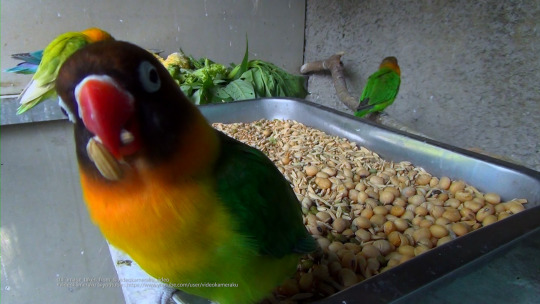
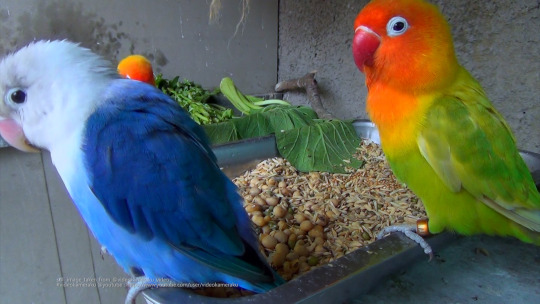
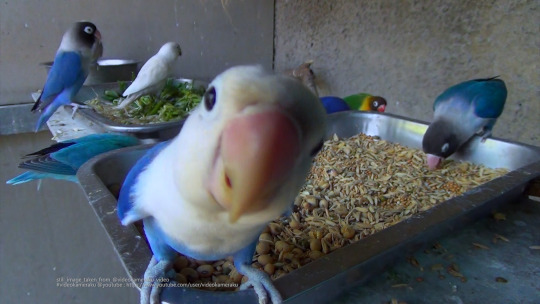
Personata and Fischer's Lovebirds - July 2023
The lovebirds are having lunch. They enjoy kale leaves, Chinese mustard leaves, and lettuce. We also feed them fresh sprouts and also sweet corn. This time we tried to serve additional seeds, they are soybeans and mung bean. The seeds must first be soaked in clean water, about an hour is enough for soybean seeds, and for mung beans it can be around 5 hours, after that the seeds will soften and are ready to be served to these little parrots.
youtube
#videokameraku#lovebird#lovebirds#love birds#love bird#lovebird video#birds#personata lovebird#lovebird personata#agapornis personata#blue fischer#lovebird fischer#lovebird ficher's#lovebird fischeri#Youtube
0 notes
Text



The photos were taken from one of our videos, in that video we recorded lovebirds enjoying microgreens. Small parrots such as lovebirds and budgies, and some other small parrots that eat seeds, love microgreens. You can make your own for your little parrot friend. It only takes a long time before harvesting it, and it only takes a short time for the parrots to finish it :D
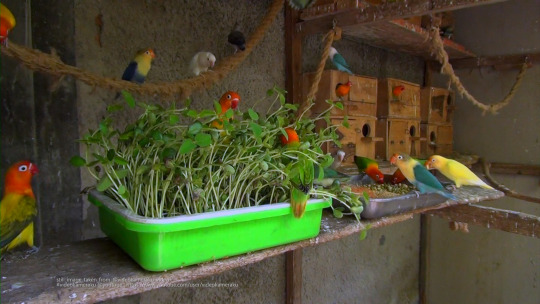
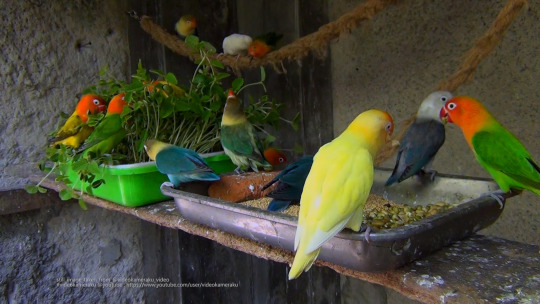
The lovebirds like to play among the microgreens, they also like to chew the seeds of these microgreens. These are grasses or microgreens from mung bean seeds and soybeans. The last few weeks we've been loving to mix mung bean and soybean seeds into our lovebirds' diets, and we've also been interested in making grass out of those seeds, which we've never done before. We are interested in that because we are curious about the appearance of these microgreens made from soybeans and mung bean. Btw, this is the definition of microgreens from several articles I've read: "microgreens are vegetables that are harvested at a very young age, between 7 and 14 days after sowing. The seeds used for microgreens are the same as the usual vegetable seeds. This microgreen phase is the phase after sprouting, usually harvested after true leaves appear."

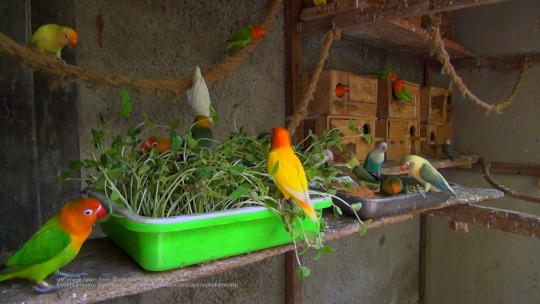
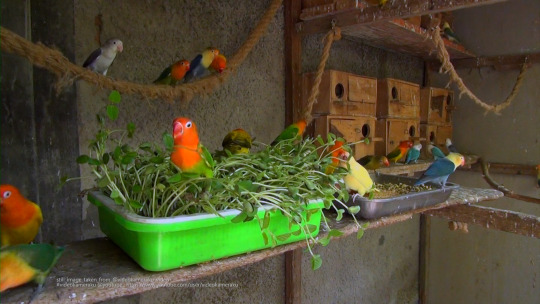
And also from several articles we read, in general, microgreens contain minerals, a source of vitamins, and beta-carotene which is higher than the vegetables themselves when mature, the best source of enzymes, high in protein, rich in fiber and low in calories. I myself do not know what vitamins are contained in the microgreens from mung bean and soybean seeds, but in outline the information above can be used as a basis for information. Microgreens are widely eaten by people because they have a distinctive taste that is different from the mature vegetables of the plant itself. And so do these little parrots, they love to play with the grass, and they love to eat it too. The microgreens from mung beans look thin, the leaves look like stars, while the microgreens from soybeans look bigger and there are very few leaves.
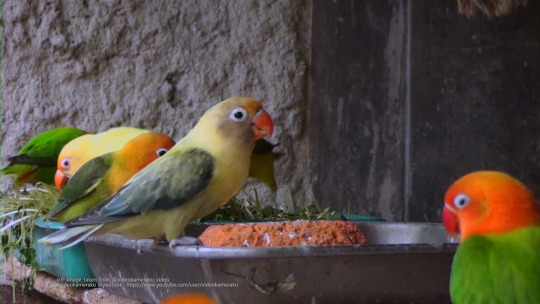


The process for making microgreens from soybeans takes approximately 7 days until harvest, while the process for making microgreens from mung beans takes a little longer. The quality of the seeds also determines the yield, the better the quality of the seeds, the less the risk of decay during processing. Of course people have their own way and experience in making microgreens, so do we. We prefer to sow seeds that have already sprouted, rather than sowing from seed form. From our experience, it is faster, and we can tell whether our seeds are all definitely sprouted or partially hollow and unable to germinate. Anyway, that's it for the short story. Please enjoy this video, enjoy watching, thank you :)
youtube
#videokameraku#love bird#lovebird#lovebirds#love birds#lovebird video#lovebird meal time#lovebird aviary#lovebirds aviary#parrot aviary#parrot video#pet parrot#small parrot#parrots#bird feeder#bird nest#bird#birds#microgreens#animal fodder#bird pet#pet bird#animal video#Youtube
1 note
·
View note
Text
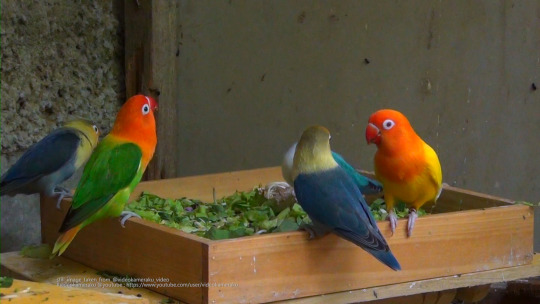
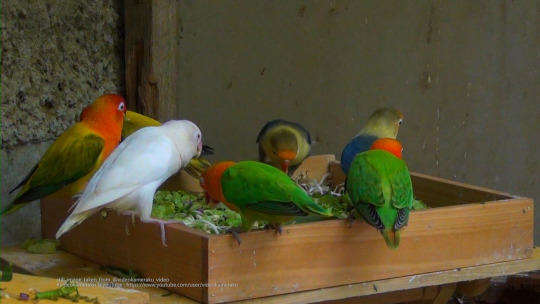

Lovebirds Meal Time June 2023
Video of lovebirds enjoying fresh vegetables and seeds. There are about more than twenty lovebirds in this simple cage aviary, most of them are adults, and there are several young lovebirds that also hatch and grow here. Here there are several types of lovebird colors, these are euwing, opaline, parblue, lutino and albino. Fresh vegetables: Green lettuce, small mung bean sprouts, large mung bean sprouts, kangkung leaves, green mustard leaves, pokcoy mustard leaves, fresh chicory, white cabbage and purple cabbage, there is also water spinach.
Fresh vegetables: Green lettuce, small mung bean sprouts, large mung bean sprouts, kangkung leaves, green mustard leaves, pokcoy mustard leaves, fresh chicory, white cabbage and purple cabbage, there is also water spinach.
youtube
#lovebird#videokameraku#love birds#lovebirds#love bird#lovebird video#lovebird avairy#lovebirds aviary#lovebird aviary#parrot aviary#lovebird meal time#lovebird mealtime#lovebird euwing green#euwing gold opaline#euwing green opaline#lovebird albino#love bird albino#love bird lutino#lutino lovebird#Youtube
1 note
·
View note
Text



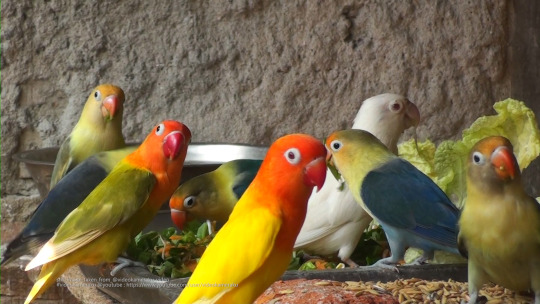
Lovebird Meal Time - April 2023
A simple aviary, occupied by lovebirds. There are several unique lovebird colors in this aviary, there are euwing lovebirds, parblue lovebirds, opaline lovebirds, and others such as creamino and lutino, and there are also albino lovebirds. The colors of this lovebird are also beautiful, green, blue, yellow, turquoise, white, violet, orange, all mixed in pastel colors and also the color patterns on some lovebirds.
This time we fed the lovebirds the usual vegetables, namely purple cabbage, white cabbage, chicory, mustard greens, mung bean sprouts, and sliced carrots and also kangkung leaves. Everything is raw with no need for cooking or boiling. Sometimes we also feed them raw sweet corn and broccoli, that too without needing to cook or boil them.
We also gave them some food seeds, namely canary seeds, millet, mustard seeds, rice seeds, wheat seeds, oat seeds, and others.
youtube
#lovebirds#love birds#lovebird#videokameraku#love bird#lovebird video#lovebird euwing green#lovebird euwing#euwing gold opaline#euwing green opaline#lovebird green opaline#green opaline#parrot video#small parrot#parrotlet#pet parrot#Youtube
0 notes
Text


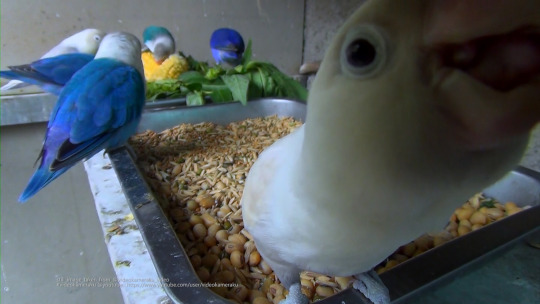
Personata and Fischer's Lovebirds - July 2023
The lovebirds are having lunch. They enjoy kale leaves, Chinese mustard leaves, and lettuce. We also feed them fresh sprouts and also sweet corn. This time we tried to serve additional seeds, they are soybeans and mung bean. The seeds must first be soaked in clean water, about an hour is enough for soybean seeds, and for mung beans it can be around 5 hours, after that the seeds will soften and are ready to be served to these little parrots.
youtube
#videokameraku#lovebird#lovebirds#love birds#lovebird video#lovebird feeding#bird feeding#parrot video#small parrot#pet parrot#parrots#love bird#lovebird fischer#lovebird fischeri#lovebird photo#lovebird personata#Youtube
0 notes
Text
Lovebirds Sounds - Euwing Fischer - Juvenile Lovebirds


Two juvenile lovebirds, these two lovebirds are siblings of one hatchling, these lovebirds hatched from the same parent and in close time. I don't know which of them hatched first, but they weren't the first to hatch at that time. They are the lovebirds of a pair of euwing blue and parblue blue/turquoise. There were five eggs, and four of them hatched. These lovebirds' parents are reliable in caring for their chicks. Evidently, of the four chicks that hatched, all of them grew well and were healthy. Until the time this video was published, the lovebirds' parents had hatched many chicks, and on average there could be up to four chicks in one hatching period. They are one of the most productive lovebird pairs in our place. And they lay their eggs and hatch their chicks in our aviary cage, which is pretty great, because usually lovebird parents are not comfortable if they have to be close to other lovebirds when they are incubating. Yes, not all lovebirds are the same, they have their own unique behavior. Just like the other animals.
youtube
#lovebirds#lovebird#lovebird sounds#lovebird chirping#lovebird singing#lovebird songs#lovebird care#lovebird video#lovebird youtube#lovebird euwing#lovebird fishcer#lovebird photo#lovebird sound#lovebird pair#lovebird hatchling#lovebird sibling#lovebird song#love bird#love birds#videokameraku
176 notes
·
View notes
Video
Lovebird Sounds - Parblue and Euwing Opaline (Feb. 2023)
These two lovebirds are lovebirds who are around 4 to 5 months old when this video was made. They hatch around the beginning of November 2023 (if I'm not mistaken). They both hatched in one of our simple cages, along with other lovebirds. These two lovebirds are from different parents, and since they were almost 2 months old or to be precise when they started to be able to feed themselves, we separated them from their parents and brought them together with other young lovebirds.
Another lovebird video with longer duration
#videokameraku#lovebird#love bird#lovebird sounds#lovebird sound effect#lovebird chirping#lovebird sinigng#lovebird chirp#lovebird songs#lovebird video#lovebird parblue#lovebird opaline#lovebird euwing#lovebird youtube
0 notes
Video
Here is a video of some of our budgie chicks hatching during 2022. There are green, yellow and more. We had lots of budgies in 2019, and as of 2022 we still have a few, not many. We have filmed some of our budgies and made them into several videos. You can see it on our youtube channel, or here.
#budgie#budgerigar#parrot#parakeet#budgie chick#parakeet chick#bird chicks#bird feeder#small parrot#green parakeet#lutino parakeet#baby parakeet#parakeet breeding#budgie breeder#budgerigar chicks
324 notes
·
View notes
Video
Lovebird Chirping Sounds - Two Lovebird Parblue - 4 Month Old Lovebird
Two juvenille lovebrids that hatched and grew up in one of our aviary cages. These two lovebirds are types of parblue, one is a chick from the pair orange-head green opaline and parblue violet/dark blue, and the other is a chick from the pair parblue euwing and orange-head green opaline. Actually I'm a bit doubtful about mentioning the color names of these lovebirds, because the lovebirds in our aviary are quite mixed in their genes and not pure (although there are some that we keep to the same gene, such as personata, fischer, opaline, parblue, roseicollis ). We feel we don't have the competence to discuss the color names of these lovebird mutations.
They grow up under the care of their parents, we don't take care of them directly because these lovebird parents are good enough of caring for their chicks. What we mean by that is, there are some bird parent who for some reason prefer to mate only but don't like to feed and care for their chicks. Like our two pairs of cockatiels, Tono and his female and also Nono and his female, they differ in how they care for their chicks. Maybe in the near future we will upload videos of their chicks. In short, these lovebird parents are good enough in caring for their chicks, although from a few eggs that hatch, not all chicks can grow to adult. This is another subject because it concerns many things. Maybe we'll do an article about it on our blog (which we haven't opened for a long time).
Anyway, in the meantime please enjoy this video, two juvenile lovebirds when chirping and singing in the morning. Enjoy watching..
Full video here
#lovebird#lovebirds#lovebird singing#lovebird sound#lovebird song#lovebirds songs#lovebirds singing#lovebirds sounds#Youtube video
109 notes
·
View notes